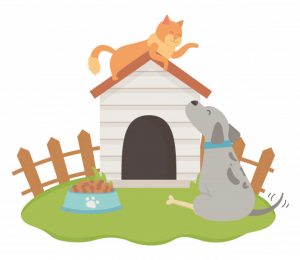 Many of us are bringing home a new pet during this tumultuous time. Whether it’s a foster friend or a forever friend, there are some management strategies that can make this easier on both the new addition as well as the humans of the household. This can be an exciting time. It’s natural for all members of the family to rush in to pet and snuggle the new addition. Other animals want to sniff and meet the newcomer as well. This can be overwhelming for the object of all the attention.
Many of us are bringing home a new pet during this tumultuous time. Whether it’s a foster friend or a forever friend, there are some management strategies that can make this easier on both the new addition as well as the humans of the household. This can be an exciting time. It’s natural for all members of the family to rush in to pet and snuggle the new addition. Other animals want to sniff and meet the newcomer as well. This can be overwhelming for the object of all the attention.
How do you set up your home for a new pet? Imagine a friend bringing their two year old over to your home completely unannounced. The toddler might run around, pull the cat’s tail, eat the lunch you left on the coffee table, and knock over your heirloom vase. If you could plan ahead, you might take steps to prevent those things from happening and prepare some structure for the child. Why then do we fail to extend the same policy to an animal entering a home for the first time? Providing boundaries and structure is essential for safety and speeds the learning process. Instead of a puppy having infinite choices, perhaps we can begin by providing two choices.
- Use baby gates to contain the dog in a manageable area where you can supervise.
- Pick up or move items that might be interesting(shoes), dangerous (your chocolate stash) or breakable.
- Provide safe retreats for other family pets if applicable.
- Set up a routine that helps the new dog learn what to expect.
Potty Training
Consistency is key! Set up a routine and set an alarm so you AND the new addition have a predictable pattern to follow. The amount of time depends on the age. Puppies under four months of age generally need to go out every two hours, sometimes more! If this is not possible for you, make sure the puppy has a safe place to potty inside where you will not be upset. For example, when my heeler cross Whimsy was a puppy, she squatted every 10-30 minutes. I literally could not take my eyes off this puppy. In order to gain some sense of normalcy, I placed a play pen on a hard floor and layered the bottom with towels(puppy pads were fun crinkly and shreddable toys to her) so I could take a break without losing my mind. Every puppy will be different, so pick a potty schedule you CAN adhere to and forgive the puppy for accidents. Like toddlers, they may not have the physical and mental development to hold it.
Adults are much easier. I will recommend starting out with potty breaks every two hours for ample chances to reward your dog for doing the right thing, but once they understand the process you can expand the time to 4-8 hours.
- Set up a schedule with an alarm if necessary(start with two hours. Decrease time if the dog isn’t successful)
- Keep the dog in the room with you so sniffing, squatting or leg lifting behavior can cue you to escort the dog outside
- Reward successful outside potty breaks. Treats or verbal praise are generally sufficient.
- Ignore accidents. Place your new friend outside or out of harms way, clean up the mess, and consider decreasing the time between potty breaks if it was too hard for the dog to hold it)
- Use an Enzymatic Cleaner such as Nature’s Miracle on cloth surfaces. The bacterial enzymes break down the mess so neither you nor your dog can smell it.
- Gradually increase amount of time between potty breaks as appropriate for the dog’s age.
Chewing:
Prevention is easier than retraining! The best advice is to remove enticing objects out of reach of the dog. If a dog has a powerful urge to chew, this may mean using baby gates or leashes to keep the dog in the room with you under direct supervision. If the dog chooses an inappropriate item, choose a dog toy of similar texture and offer to play a game with the dog to make it more fun. Consistent interruption and redirection will teach the dog which choices bring the most reward. Avoid simply taking the object or punishing the dog, as this can teach the dog that allowing you near is bad and teach the dog to guard it. In more playful pups, this can also become a fun game of chase and tug! So exchange and make that exchange a joyful occurrence as you join in the play. Consider different items to offer your pet for chewing.
Introducing Multiple Pets:
Most of us are aware that dogs are territorial in nature. It make it easier for the dog to meet in neutral territory and go for a walk. Have a friend or family member meet you on the street and simply walk side by side chatting. Do not allow the dogs to go nose to nose(keep distance) until they are completely relaxed and the walk is over. If all is well, take them to the yard and drop leashes(leashes make excellent handles if things get tense). If the dogs don’t immediately love each other, they may need time to adjust and it is best to keep them separated in the house. Even if things look promising, keep dogs under supervision. They have no history of trust yet, so it’s easy to become annoyed or concerned with each other.
With other species in the household, you will need to keep the new dog leashed and under supervision until you know how they react. Whether a dog show play behavior or prey behavior, cats and smaller pets need safe spaces to get away from the dog. Cats like a variety of hidey spots both high and low. If the dog shows uncomfortable interest in the other animals, offer a game or an opportunity to earn some treats. Any persistent attention may require a professional evaluation to see if they will be safe together.
For more tips on bringing home a new pet, visit Karen Pryor Academy!
